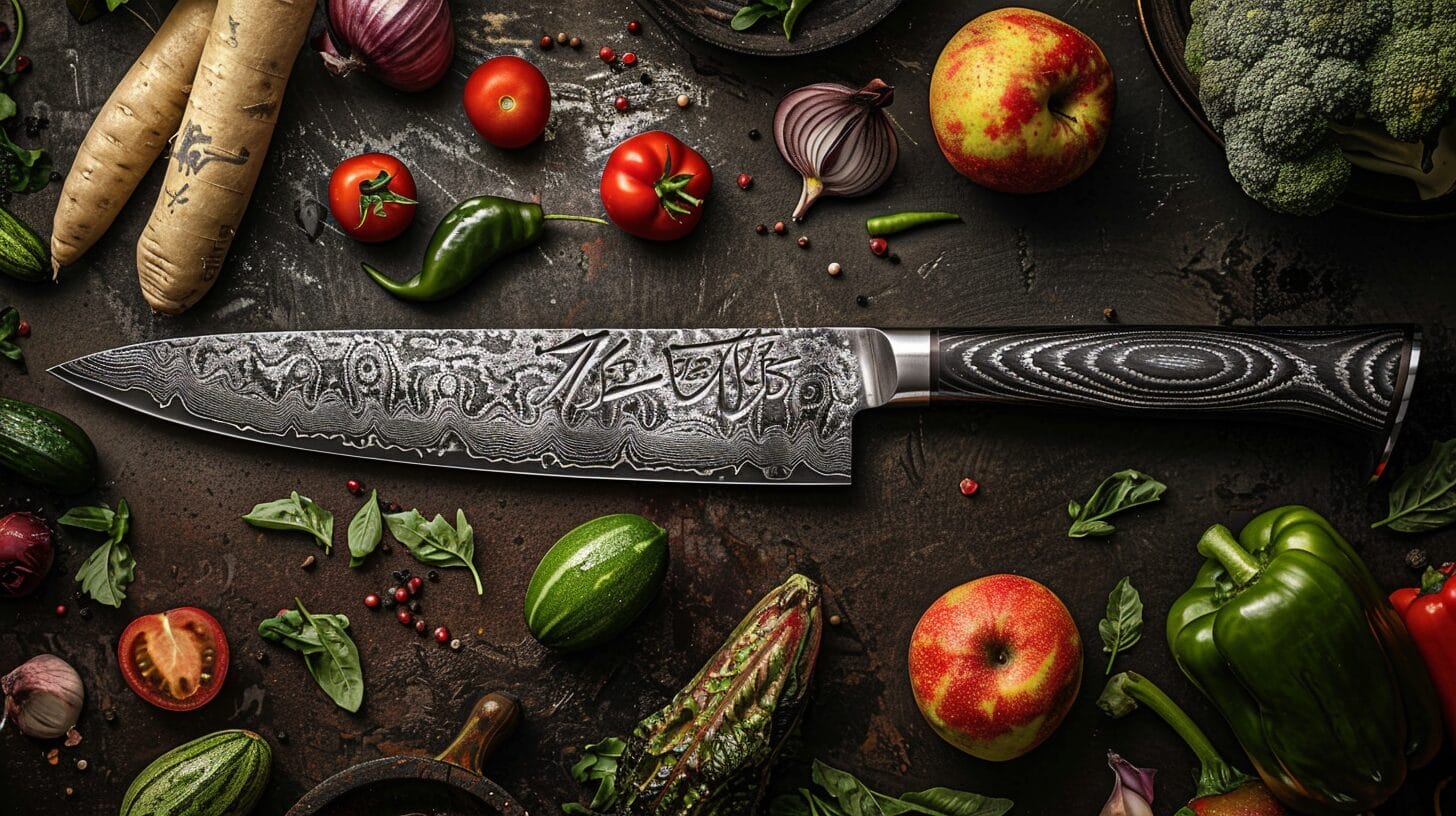When it comes to the reputation of Damascus steel in the realm of knife making, its performance is a topic of ongoing discussion. Enthusiasts and professionals often debate the practicality and desirability of Damascus steel knives. Before deciding on their suitability, it is crucial to weigh various factors that impact the quality and functionality of these knives.
Key Takeaways
When considering Damascus steel for knives, it proves to be a solid option for those who value both functionality and aesthetics. While it may require a bit more maintenance to prevent corrosion, the blade’s durability and sharpness make it worth the extra effort. With a variety of Damascus steel types available, you can choose one that suits your needs and personal preferences. Hence, if you are looking for a high-quality knife that is visually appealing, Damascus steel is definitely a worthwhile option to think about.
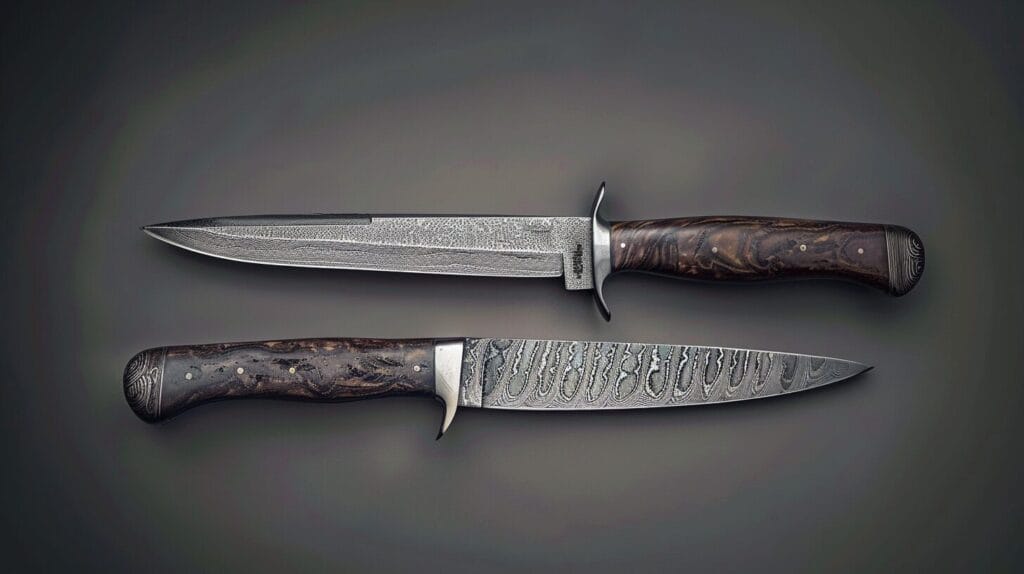
How does Damascus steel compare to other high-quality knife steels in terms of edge retention, sharpness, and durability?
Damascus steel is renowned for its unique blend of durability, sharpness, and edge retention, making it a top choice among high-quality knife steels. By carefully selecting the steel, applying the right heat treatment, and employing precise craftsmanship, Damascus steel knives excel in performance compared to other premium materials.
Steel Selection
Damascus steel knives typically offer exceptional edge retention, impressive sharpness, and good durability. Damascus steel, known for its high-carbon composition, holds its edge well, making it ideal for prolonged use without frequent sharpening. The layered construction of Damascus steel blades allows for a fine, sharp edge that can maintain its cutting ability over time. Additionally, Damascus steel combines sharpness and beauty with good durability, ensuring the knife can withstand regular use without significant wear.
Heat Treatment and Tempering
In order to understand the performance of Damascus steel in relation to other top knife steels, it is crucial to focus on the precise heat treatment and tempering processes. These processes are vital for achieving the right balance of hardness and flexibility in Damascus knives. Through meticulous heat treatment and tempering, Damascus blades can maintain a sharp edge while avoiding brittleness and chipping. Damascus steel stands out for its excellent edge retention and sharpness when compared to other high-quality knife steels. The unique layering patterns in Damascus steel not only enhance its visual appeal but also improve its overall functionality. With proper heat treatment and tempering, Damascus steel emerges as a strong competitor in terms of both aesthetics and performance.
Precision Craftsmanship
Assessing the Performance of Damascus Steel
When evaluating Damascus steel in comparison to other high-quality knife steels, it is essential to consider the intricate craftsmanship that plays a crucial role in its edge retention, sharpness, and durability.
- The labor-intensive forging and shaping process significantly improve cutting performance and edge longevity.
- Damascus steel’s performance does not inherently surpass steels like 3V or 80CRV2.
- The overall durability and toughness may vary depending on the specific steel types used and the manufacturing process employed.
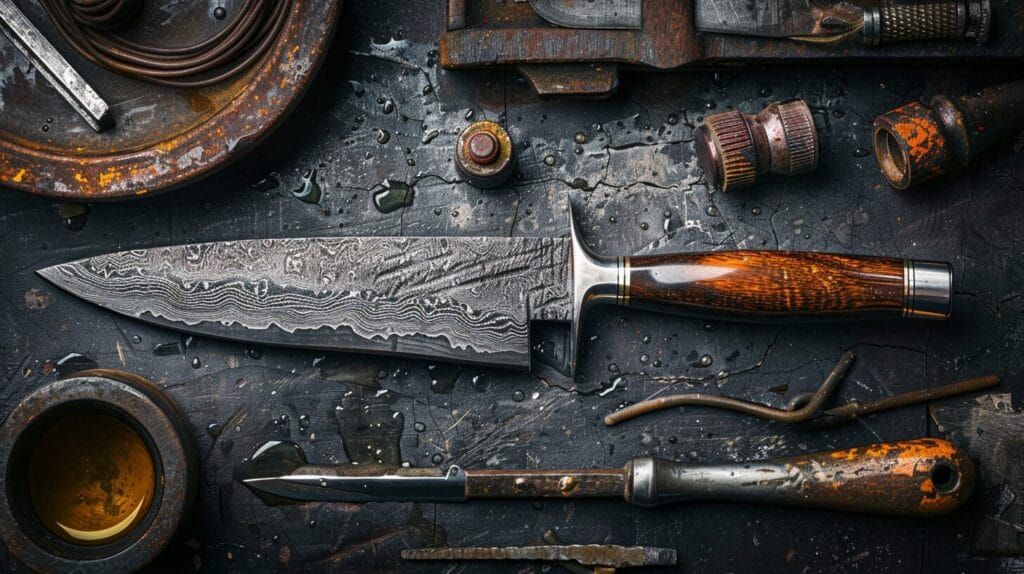
Is Damascus steel more difficult to maintain than other knife steels? Does it rust easier?
Caring for Damascus steel knives is not more challenging than caring for other knife steels; they are not more prone to rusting either. You can maintain the quality of your Damascus steel knife by avoiding moisture, using proper cutting surfaces, regularly oiling the blade, sharpening correctly, and steering clear of harsh chemicals. With these simple steps, you can ensure that your Damascus steel knife remains sharp, rust-free, and visually striking for years to come.
Avoid moisture and humidity
When it comes to maintaining Damascus steel knives, keeping them dry is essential to prevent rust and corrosion. Here are some tips to help you preserve the quality of your knives:
- Dry the knife thoroughly after each use, especially if it gets wet.
- Store the knife in a dry place to avoid moisture retention.
- Consider applying a protective coating or oil to add an extra layer of defense against rust.
Avoid abrasives and harsh chemicals
When cleaning your Damascus steel knives, it is important to steer clear of abrasive materials like steel wool and strong chemicals. These can harm the intricate patterns on the blade’s surface. Instead, stick to mild soap and water for cleaning. Steel wool can leave scratches, and harsh chemicals might lead to discoloration or corrosion. By opting for gentle cleaning methods, you can ensure that your knives maintain their beauty and functionality over time. Remember, a little care in cleaning can go a long way in preserving the stunning appearance of your Damascus steel knives.
Regularly oil the blade
When it comes to your Damascus steel knife, preventing rust is essential. Follow these steps to keep your knife in top condition:
- After each use, apply a thin coat of food-safe mineral oil.
- Store your knife in a dry place to prevent excess moisture.
- If you see any rust spots, gently scrub them off with a non-abrasive material.
Use the right cutting surfaces
Choosing the right cutting surfaces for your Damascus steel knife
When caring for your Damascus steel knife, it is crucial to select the appropriate cutting surfaces to maintain its quality and longevity. Using the wrong cutting surfaces can significantly impact the maintenance of your knife, leading to faster rusting and dulling of the blade. To prevent this, avoid cutting on hard surfaces like glass or stone, as they can dull the blade more quickly. Instead, opt for softer surfaces such as wood or plastic to help preserve the sharpness of the Damascus steel blade.
Damascus steel knives are renowned for their durability and sharpness, but they can still rust if not properly cared for. By using appropriate cutting surfaces, you can prevent unnecessary wear and tear on your knife, ensuring it remains in top condition for longer periods. Remember, the right cutting surface plays a vital role in maintaining the quality and longevity of your Damascus steel knife.
Sharpen properly
To properly maintain the edge of your Damascus steel knife, it is essential to use whetstones and honing techniques suitable for this specific steel type. By following these steps, you can prevent damage to the pattern while ensuring sharpness and longevity:
- Start by using a whetstone with a finer grit to maintain the sharpness of the blade.
- Avoid diamond sharpening stones as they can wear down the pattern of the steel.
- Regularly hone the edge of the knife to keep it sharp without removing excess material.
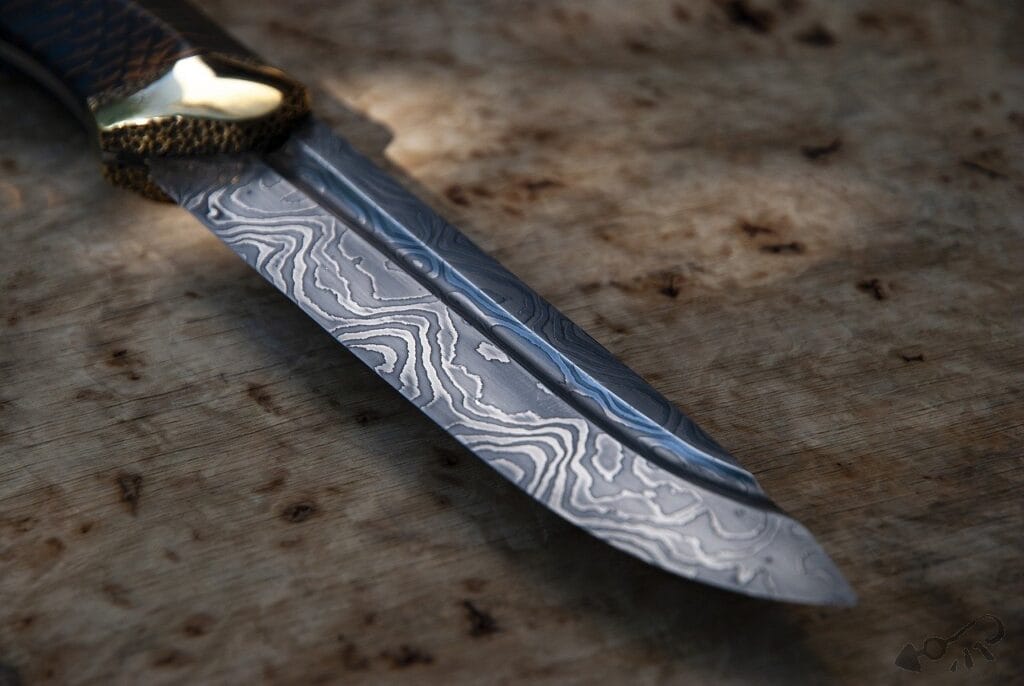
Are Damascus knives worth the extra cost compared to knives made from single-type steels?
When considering the price difference, Damascus knives stand out due to their intricate forging process, which creates the distinct wavy pattern on the blades. This process makes them pricier to manufacture. The historical allure and unique aesthetics of Damascus steel also play a role in their higher price point, with consumers often seeking out the swirling patterns and layered construction.
On the other hand, knives made from single-type steels like stainless steel are generally more affordable due to their simpler production process. Despite the higher cost, Damascus knives can offer superior edge retention and sharpness, thanks to their layered construction and specific steel alloys. They are also known for their durability, combining hard and soft steel layers for strength and flexibility.
Ultimately, whether Damascus knives are worth the extra investment depends on individual preferences and priorities.
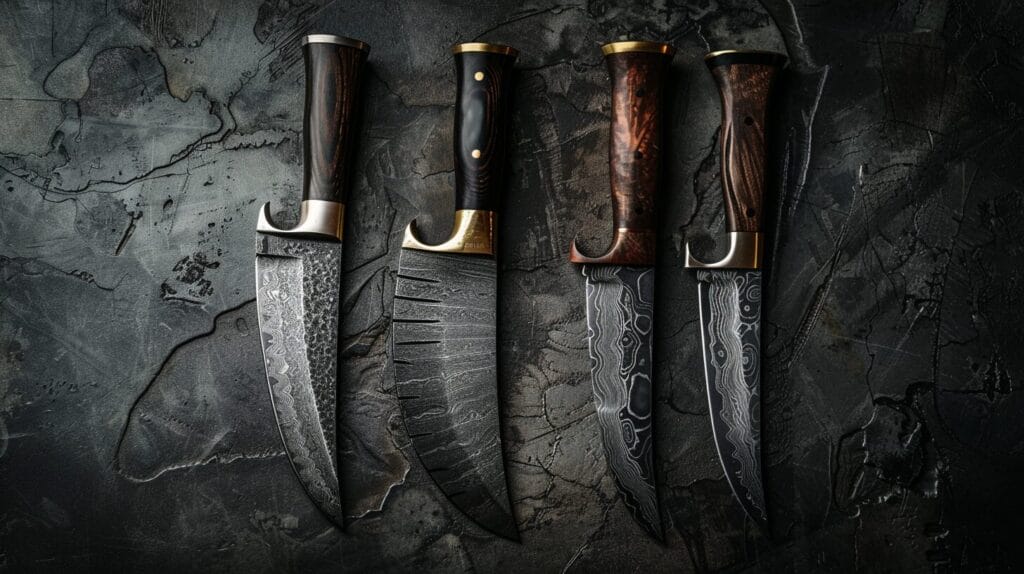
Are there different qualities of Damascus steel, and how do they affect the knife’s performance?
When looking at Damascus steel for knives, it’s important to understand the various types available and their impact on performance. Traditional and modern Damascus steel variations offer different qualities that affect cutting ability and durability. The quality and composition of the steel layers can significantly influence the knife’s overall performance.
Traditional Damascus steel
When it comes to the performance of a knife, Traditional Damascus steel stands out due to its exceptional strength and durability. Crafted from Wootz steel, this type of steel is known for its ability to maintain a sharp edge over time, making it ideal for various cutting tasks.
The forging techniques and layering process involved in creating Traditional Damascus steel knives are crucial factors that contribute to their high performance. To ensure top quality and performance in a Damascus steel knife, it is important to look for blades that have been crafted with meticulous attention to detail.
This level of craftsmanship not only enhances the knife’s durability but also improves its cutting capabilities, making it a reliable tool in the kitchen or outdoors.
Modern Damascus steel
Modern Damascus steel is made by combining high-carbon steel and stainless steel, creating a distinct pattern on the blade. This type of steel differs from Traditional Damascus steel in its composition and appearance. The unique design of Modern Damascus steel is achieved through layering and folding different steels, resulting in a visually appealing blade.
The inclusion of high-carbon steel and stainless steel enhances the durability and corrosion resistance of Modern Damascus steel, making it a popular choice among knife enthusiasts. The layering process not only adds to the aesthetic appeal but also improves the strength and performance of the knife, making Modern Damascus steel highly sought after in the world of knife making.
Quality and performance
Quality and performance of Damascus steel knives depend greatly on the specific steel types used and the manufacturing process. A good Damascus steel knife typically consists of a hard, high-carbon steel core surrounded by softer, more flexible outer layers. This combination provides a balance of edge retention and resilience. The hardness of the core steel is usually measured in HRC (Rockwell Hardness) and can range from 58-64 HRC. Higher numbers indicate superior hardness and edge retention. In contrast, cheaper or lower-quality Damascus steel knives may lack this optimal layering, which can compromise their overall performance and durability.
Types of Damascus Steel and Their Impact on Knife Performance
When considering Damascus steel for knives, it’s important to understand the different types and how they can affect the performance of the blade. The qualities of Damascus steel, such as the metals used, the forging process, and the craftsmanship, play a crucial role in determining the overall performance of the knife.
Here are some common types of Damascus steel and their characteristics:
- Wootz Damascus: Known for its high carbon content and excellent edge retention, Wootz Damascus steel blades offer exceptional sharpness.
- Pattern-Welded Damascus: This type is renowned for its visually striking patterns and good flexibility, providing a unique aesthetic appeal to the knife.
- Crucible Damascus: With a consistent composition and high strength, Crucible Damascus steel knives boast enhanced durability.
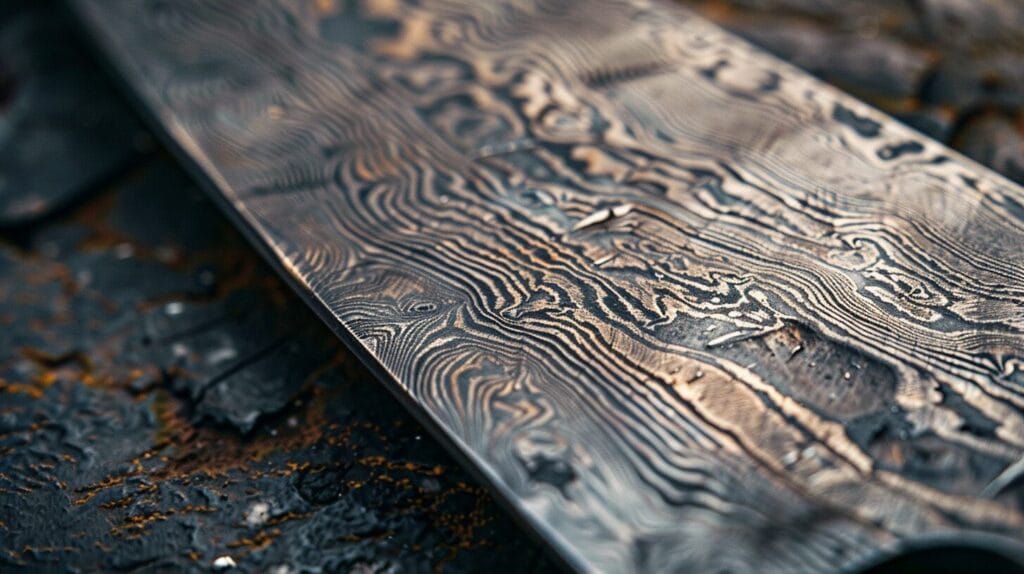
Is the Damascus pattern on this knife just for aesthetics, or does it indicate a specific forging process?
The Damascus pattern on a knife serves a dual purpose, as it is not merely ornamental; it signifies a specialized forging technique that improves the blade’s performance. Through a unique forging process involving layering and folding different steel types, the Damascus pattern is achieved. This process results in a blade composed of alternating high-carbon and low-carbon steel bands, enhancing its mechanical properties. Here are three essential points to consider:
- The layering and folding of steel in the Damascus forging process enhance the blade’s durability.
- The Damascus pattern increases the blade’s flexibility, reducing the risk of breakage.
- The composite nature of Damascus steel improves the blade’s edge retention, maintaining sharpness over extended periods.
Frequently Asked Questions
How Does Damascus Steel Compare to Other High-Quality Knife Steels in Terms of Edge Retention, Sharpness, and Durability?
Damascus steel stands out from other high-quality knife steels due to its unique blend of exceptional performance, intricate patterns, and historical craftsmanship when it comes to edge retention, sharpness, and durability.
Is Damascus Steel More Difficult to Maintain Than Other Knife Steels? Does It Rust Easier?
Maintaining Damascus steel knives isn’t necessarily harder than other types. Regular cleaning and oiling prevent rust. While it requires a bit more care, the unique patterns and excellent performance make it worth the effort.
Are Damascus Knives Worth the Extra Cost Compared to Knives Made From Single-Type Steels?
Damascus knives are worth the extra cost compared to knives made from single-type steels because of their unique patterns and exceptional performance. The craftsmanship and durability of Damascus knives make them a valuable investment for serious knife enthusiasts.
Are There Different Qualities of Damascus Steel, and How Do They Affect the Knife’s Performance?
In selecting Damascus steel knives, it is crucial to consider the diverse qualities available. The type of steel, forging techniques, and layering patterns all play a significant role in influencing the knife’s performance. Having a good understanding of these aspects will assist you in making a well-informed decision when choosing the best knife to meet your requirements.
Does the Damascus Pattern on a Knife Indicate a Specific Forging Process, or Is It Just for Aesthetics?
The Damascus Pattern on a knife is a result of a specific forging process. It is not solely for aesthetics; it also signifies the skilled craftsmanship involved. This intricate design serves as a reflection of the careful technique utilized in forging the blade.
Conclusion
In general, Damascus steel is a great option for knives if you care about both performance and appearance. Although it might need a bit more upkeep to avoid rust, the blade’s longevity and sharpness justify the additional care.
With various types of Damascus steel to choose from, you can select one that meets your requirements and preferences. Therefore, if you’re seeking a high-quality knife that is visually appealing, Damascus steel is certainly a worthwhile choice to consider.

